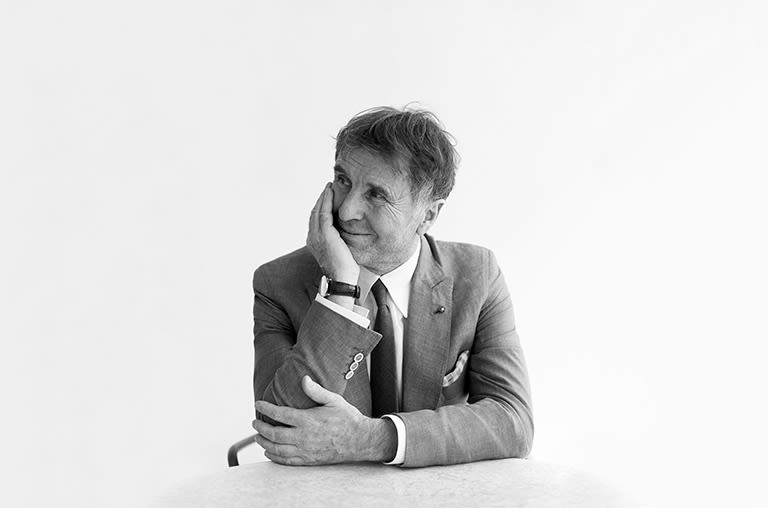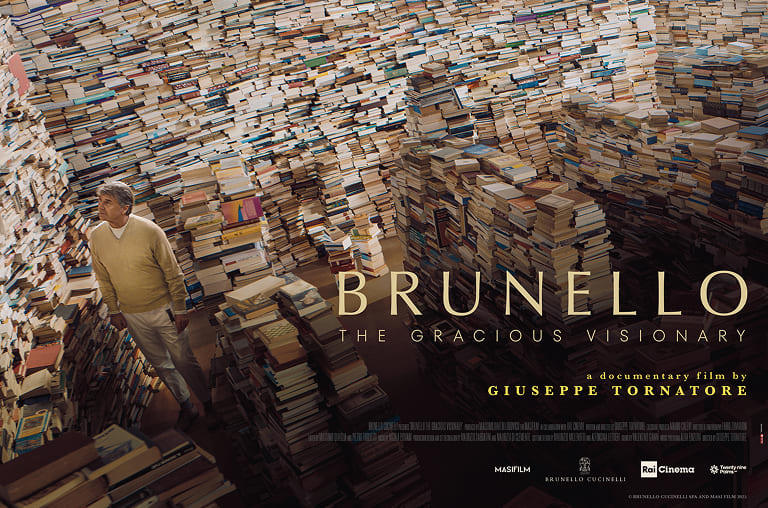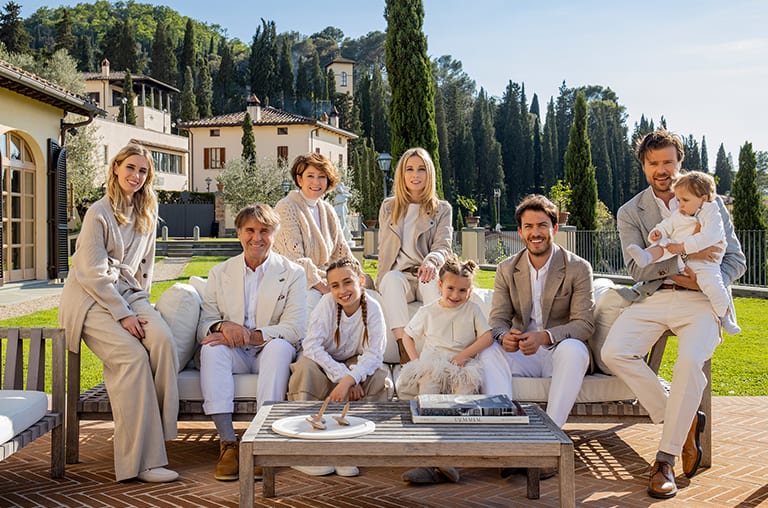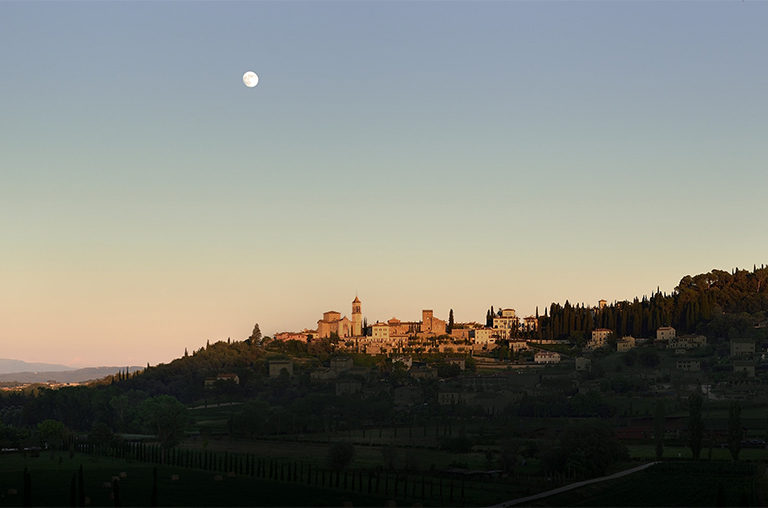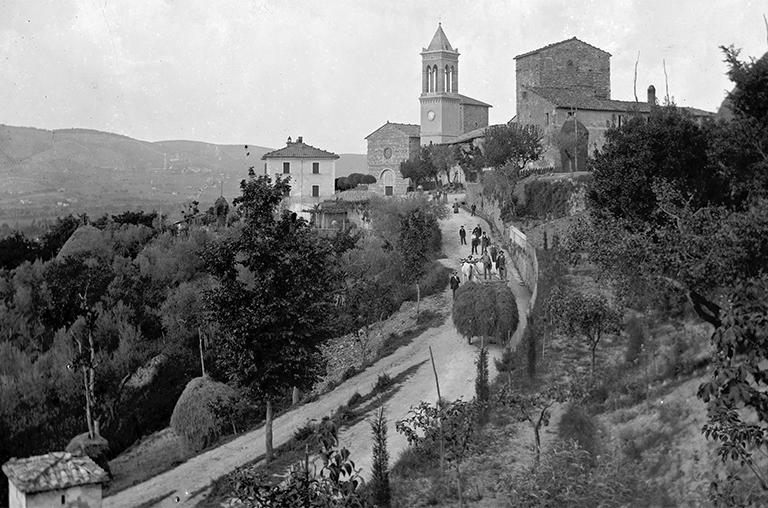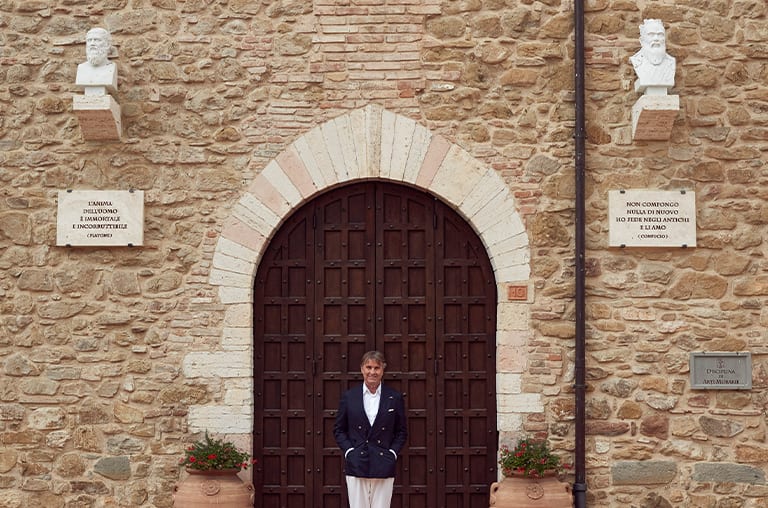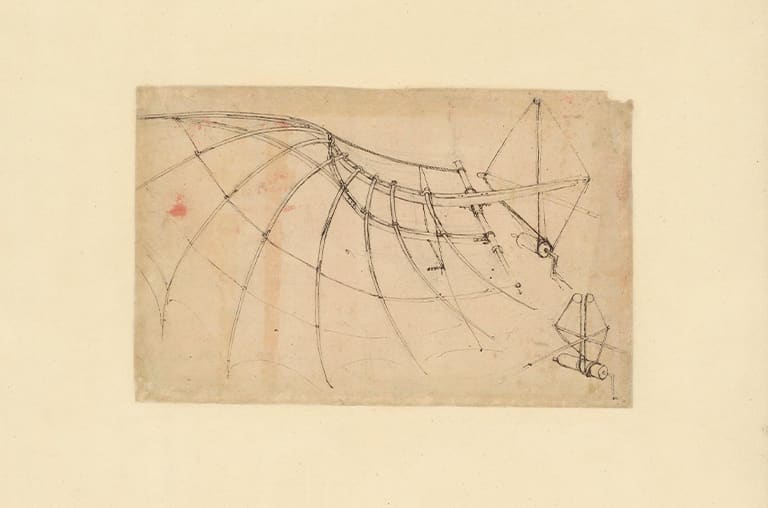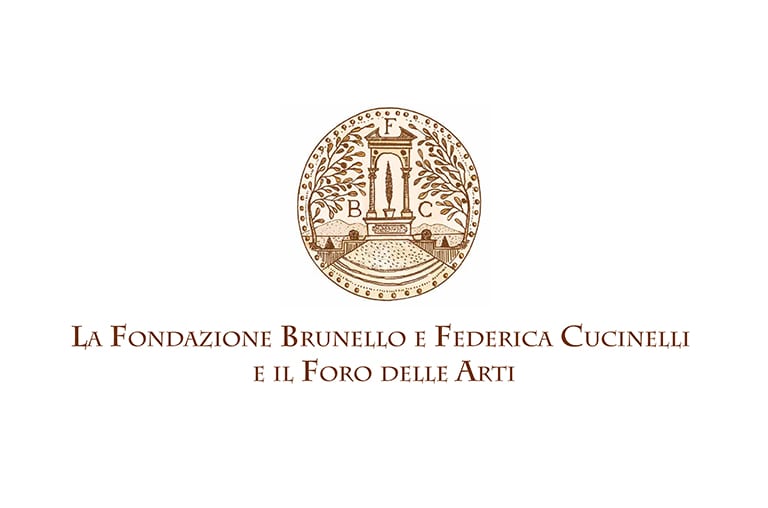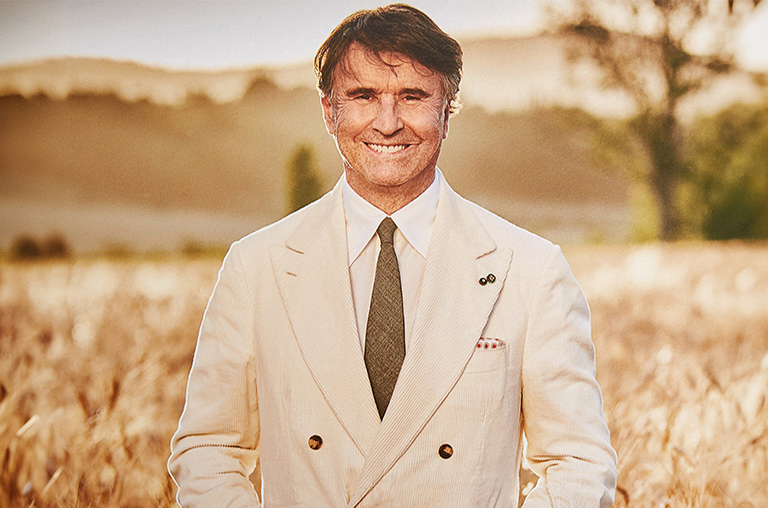label.skip.main.content
The Origins of the Company

View of Solomeo from the main street to the hamlet, 1913
‘When I was 24 years old, I was hired as a model by a sportswear company located near my house; it was a leading company in the global ski and tennis sector. I used to always dress well, read fashion magazines and stay updated on the latest trends. In this way, I gradually moved towards the future and at the age of 25, I made my decision: I wanted to make colored cashmere sweaters, only for women, in line with contemporary style. I had the impression that it was a very innovative idea. I was firmly convinced of the idea of producing high-quality garments that reflected Italian craftsmanship and manual skills, items that were certainly expensive but not excessively so, designed for a market segment called “absolute luxury”. I’ve always believed that to do something special you have to focus on a single project that is your lifelong dream.
In the beginning, I was driven by haste and instinct. Today I’m all the more convinced that you have to take action even when your hopes are low, because sometimes utopias turn into incredible successes. There was great uncertainty at first, as it often happens, but I held steady, and one day there was a positive change.
I still hold dear the memory of that good man and great professional whom I asked to sell me about twenty kilograms of ecru-colored cashmere yarn, a sufficient amount to make about sixty sweaters. With a fatherly gesture, he told me that he would have certainly sold them to me, then he said something that still moves me deeply, “You’ll pay me when you earn your first money. I know you, you’re a good young man”. Unfortunately, he suffered a serious illness in early old age and I didn’t have the chance to thank him as much as I would have liked.

Image with illustration by Sunflowerman
A special moment was when I went to a dyeing plant and met Alessio for the first time, perhaps one of the greatest experts in cashmere dyeing. I brought him six women’s cashmere sweaters and I asked him to dye them in six different colors, which were not too bright, however. At first his sharp reply was, “You’re crazy to dye cashmere in these colors”. For most of the morning I tried to convince him in every way, begging him to do as I asked. In the end he told me, “Let’s give it a try, but I can’t guarantee the result”. This was undoubtedly the most important moment in my life. I owe a lot to this man: a joker, an idealist, a dreamer who was very devoted to his roots.
I had read in a specialized magazine that in Trentino Alto Adige customers ordered and paid in a timely manner like nowhere else in Italy. I set off on my journey right away, and my first customer was Albert Franz from a beautiful little town near Bolzano called Naturno, who was the owner of a boutique and who is still a customer of ours today. Mister Albert was a strong man, who was more or less my dad’s age and had a beautiful family. His behavior was exemplary from the start: professional, accurate, rigorous and humane. There was affinity between us, as well as esteem, so we started working together. Without any doubt I will always remember in my heart his first order for fifty-three cashmere sweaters.
I had no financial means, so the only thing I could do was to find funds from good payers. Therefore, I decided to go to Germany to look for customers, because I knew that Germans were very professional and paid in a timely manner. And so Germany became the first country I worked with and today I still remember with gratitude those early adventurous times where Germans were my amiable companions.

Brunello Cucinelli in his studio at the Solomeo castle, 1999
I also hold loving memories of Vincenzo, one of my first customers who lived and worked in Milan. He used to talk to me about Puglia, his homeland, about his tormented arrival in Lombardy, about living in a wooden shack until it was knocked down by the strong winds, an episode that was so unbelievable that it ended up in the newspapers. I used to listen to him, drawn by the charisma of a good soul: his words flowed smoothly. One day, he made a very significant order and said to me, “This is the money, I want you to use it for your business”; it was a lot of money, I was speechless: to understand my state of mind just think about those tough early years and the little amount of money that I managed back then. Instinctively, regardless of my own personal interest, I asked him what guarantees he thought I could give him, since I had no money or possessions. With a benevolent smile on his face, he told me, “I have five brothers, and with me it makes six, and then there’s my father and my mother; and we all believe in your entrepreneurial and moral skills, we believe in you. This is enough for us; so don’t worry about the money, just keep your head down and work without worries, and that’s all”. That type of situation really unleashed my skills and made me want to surpass myself. And that’s what I did.
Vincenzo became one of my first financial supporters, and I’ll always be immensely grateful to him; he was a simple man, a man of his word. His death, when he was only fifty years old, deprived me of a dear friend.
At the time I was pretty much lacking in financial literacy, and I knew nothing about my competitors, but this didn’t matter much, what mattered was the power of my enthusiasm, which from then on has grown constantly. I felt like I had been preparing for this basically my whole life, and that was a life-changing moment for me.
My farming background and my personal experiences had a lot to do with this decision. I remember once again how painful it was to listen to the humiliations that my father used to bear in the factory and to see his teary eyes, and how such pain has turned into the firm rejection of any offence to the dignity of people. My moral imperative was to never fail to respect human values, a tenet that I still constantly abide by.
I believed in creating valuable items without causing any harm to Creation, or as little as possible. I imagined products that could be just as gratifying for the wearers as they were for the workers who made them, I imagined people working in a beautiful workplace: a place where workers had pleasant and relaxing breaks, where the artisanal dimension reigned supreme. I wanted human relations to respect humanity and truth, and wages to be sufficient to live a dignified and serene life. The working atmosphere that I imagined was a peaceful one where creativity could be unleashed. I imagined making profit, indeed, but based on ethics, dignity and morality, trying to give form to the fascinating relationship between “profit and giving back” that made me feel, in my own small way, as a custodian of Creation.
In this sense, Saint Benedict was my brilliant role model, who combined the most benevolent paternal humanity with great rigor in praying and working, two aspects that have been inextricably linked together over time. I often recalled a certain recommendation that this great saint used to make to every abbot, “Be both rigorous and gentle, a strict teacher and a tender father”.
At the time, my mind used to wander back to my dad’s teachings: if you are not a good person you won’t have people’s respect; the professionalism, courage and transparency of one’s actions, in other words, respect for dignity, your own and others’, are fundamental in life.
When the right time came, Federica and I decided to get married and go live at her house in Solomeo. During those early years, my successes were only limited but they seemed extraordinary to me. I started thinking about moving my tiny factory, which back then was located in the suburbs of Perugia, to new headquarters. And Solomeo came to my mind; I couldn’t stand seeing this small ancient hamlet so degraded and neglected and one day, instinctively, I thought I’d try to purchase the tower and medieval castle. I was enchanted by those buildings, which bore the marks of their long history, they seemed eternal to me, the perfect headquarters for my small company, right in the heart of this picturesque medieval settlement.

One of the circumstances that, among those that happened to me, best symbolizes the sense of life were the touching negotiations for the purchase of the Solomeo castle. At the time I was still a young man, and in front of me was the owner of the castle, a man whom I had heard was a very amiable person but very firm and unyielding in his convictions. Mine, after all, was an almost desperate attempt. Unexpectedly, the meeting had a magic effect, it uncovered a kindness of spirit that we had in common, shared feelings and desires. It took great and sincere efforts, but in the end, when the owner understood that I wanted to preserve the castle in its entirety and turn it, over time, into a place for the benefit of humanity, he agreed to sell it. My dreams were his dreams; they were big, visionary dreams. Perhaps he saw in me someone who could pursue something that he could no longer pursue because he didn’t have the strength or the time to pursue it, and he cared about me.
It was one of the first times I experienced the tangible importance of dialogue, and the fruits borne from speaking in a straightforward and honest way and from sharing key values: human respect, custodianship, preserving traditions, industrial product quality. People must not only be respected in form, but most importantly in substance. As I said, I believed that people should work in special workplaces as close to nature as possible. I believe it is useful to pass on humanistic values, such as the family, spirituality, craftsmanship and agriculture, because in them lie the roots of the future.

Brunello Cucinelli together with his daughters Camilla and Carolina and their respective spouses, Riccardo Stefanelli and Alessio Piastrelli, at the event at Chateau Marmont in Los Angeles, December 2024.
Confucius thought that restoring ancient rituals and using proper language were essential to favor the progress of humanity. He used to say, “I transmit, but I don’t create”. So it is not about nostalgia for the past, it is about authentic values in which we find all the answers we are looking for in order to shape our future. That is why I have always felt like a sort of guardian, like a "ferryman" between the past and the future, even to this day.
By purchasing the castle I would have fulfilled three key objectives: to work in a beautiful ancient place full of charm; to have a monumental building that I could use as collateral with the banks, rather than an industrial facility; and lastly to restore the fortress and the hamlet, which over the next twenty years would have probably witnessed a strong economic revaluation and an improvement in the quality of life.
At the time, many people disliked living in small towns, because there was a tendency to move to the city where, just like my family did, they hoped to find improved living conditions both economically and socially.
I did the exact opposite, and moreover the company was continuing to grow at the same pace as my passion for this hamlet; so much so that I started imagining a sort of rebirth of the hamlet. I see this as the beginning of my project for the company and for Solomeo.
Then came a time when I had to start thinking about how I wanted to communicate my idea of industry and its values: the little advertising we did in fashion magazines focused on themes representing Italian culture, village life, dignity, respect, education, kindness and the value of the custodianship of places. In May 1996, we released a photo depicting father Gualtiero – a Franciscan friar, who was a dear friend of mine –, model Letizia and I, while looking at some ancient books belonging to the priceless library contained in the Franciscan monastery of Monteripido, near Perugia. We came up with a beautiful caption expressing the positive atmosphere of the moment, a real dream for that year. It read, “We need a new Humanism”.
But going back to Solomeo, things were going well, our reputation was growing, and so was the company; on the one hand, Made in Italy cashmere, product innovation and modernity; on the other hand, our special relationship with human values, our philosophic vision, our projects for humanity, and our willingness to serve, for our part, as custodians and “ferrymen” of traditional values.
In the small hamlet, restoration works were completed. The quality of life of its inhabitants seemed amiable to us, in the medieval castle people worked in a pleasant and friendly working environment. We thought it was normal to have no difference in remuneration between blue-collar and white-collar workers, we thought it was fair to have slightly higher than average wages or even a bit higher for those with artisanal skills. We used to hold assemblies every three months to talk about everything, from more general company issues down to the smallest detail. Every single aspect, no matter how minimal, was analyzed. For example, we gave great importance to lunch breaks in the company’s restaurant, which serves traditional Umbrian dishes. In the morning, the working day started at 8:00 A.M. for everybody. Nobody had to clock in or out. In the evening, the working day ended at 5:30P.M. These are fair concepts, in my opinion, universally sound ones.
Then the first important interviews started with international publications that were curious about what was happening in that small and until then little known Umbrian town: how could people work well in a medieval hamlet? How could this ancient castle be more efficient than a functional and cutting-edge facility? The Internet was still far from its current development and people thought we were pretty isolated, because today’s economy requires real-time connections. The building had many internal stairs, small rooms, and its walls were inalterable because many of them were decorated with frescoes. Actually, the workplace worked perfectly and, although it was unsuited for the hasty pace of modern times, it was suited in the spirit, and that’s what mattered most.

Illustration by Sunflowerman
Technology, however, was advancing very rapidly; Amazon and Yahoo were launched; in Europe people started to consider the Internet as a big revolution; it wasn’t yet known to all, but the web would have soon become the greatest revolution of the third millennium that was about to begin. Today we feel and perceive this amazing new atmosphere, poised between apprehension and great expectations.
The increased interest in Solomeo did not only attract journalists, but the cultural sector in general. In 2001, the Bocconi University in Milan conducted a special study on Solomeo. On the one side, there was our unique philosophy and on the other side our sound company results; we didn’t make excessive profit nor was it our objective: we pursued fair growth, fair profit, we wanted everything to be civilized.
We became a first-class company at the global level: from knitwear to total looks up to the search for a contemporary, casual yet chic style. We developed comprehensive collections for men and women, including ready-to-wear, footwear and accessories, and we launched the retail channel with mono-brand boutique openings in Europe, America and Asia.

However, the deepest meaning of any human action lies in our origins, and we believe that our international success was built on the right choices we made in those early years, starting with the decision to follow my father’s moral teachings, when he used to always tell me to be a good person. In the great “Universal History” by Ibn Khaldūn, an Arab thinker from the 14th century who for Middle Eastern culture is deemed as important as Dante and Shakespeare in the Western world, the concept of “fairness” is treated in a way that is totally applicable to us. It’s a value that I’ve known since my childhood, because it was always present in the farmers’ prayers for a fair harvest.’








